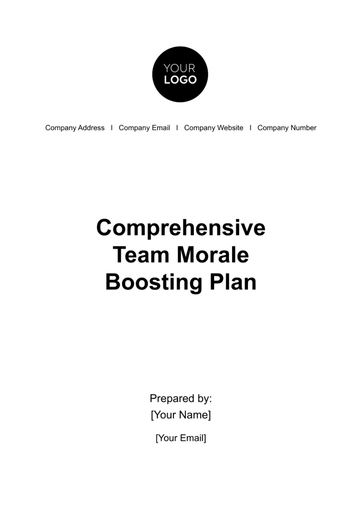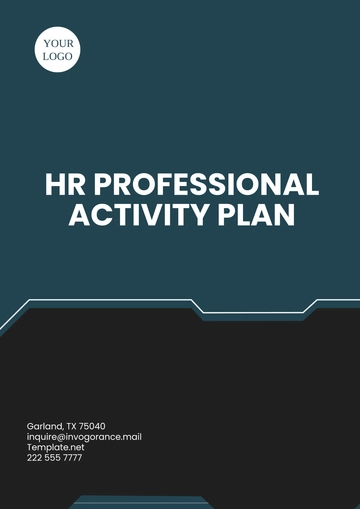Free Interior Design HR Plan

I. Executive Summary
[Your Company Name] is committed to fostering a workplace that not only drives creativity and innovation but also supports and develops its human resources. This HR plan outlines a strategic approach to managing the workforce of our Interior Design department, focusing on recruiting, training, and retaining highly skilled professionals. By aligning HR initiatives with our business objectives, we aim to enhance client satisfaction, optimize project delivery, and maintain a competitive edge in the market.
Our HR strategy will serve as a comprehensive blueprint, guiding all HR activities and decisions, with a keen focus on the unique challenges and opportunities within the interior design industry. This document will detail actionable steps to attract, develop, and retain talent that embodies the aesthetic and functional principles that set [Your Company Name] apart.
Quantitative Goals:
Employee Retention: Reduce turnover by 10% within the next fiscal year.
Employee Satisfaction: Achieve an employee satisfaction score of over 85% as measured by annual surveys.
Productivity Metrics: Increase team productivity by 15% through enhanced training and development programs.
II. Organizational Structure
To promote efficiency and innovation within our Interior Design department, [Your Company Name] has developed a streamlined organizational structure with clearly defined roles and responsibilities. This structure is designed to foster communication and collaboration among team members, facilitating a creative and productive work environment.
Organizational Chart:
Senior Interior Designers: Lead design projects and mentor junior designers. Responsible for high-level design concepts and client management.
Junior Designers: Support senior designers with detailed designs and client presentations. Focus on developing design skills and understanding client needs.
Project Managers: Oversee project execution, ensuring adherence to timelines and budgets. Act as the primary point of contact for all project-related communications.
Flexible Roles:
We encourage flexibility in roles where team members can take on cross-functional tasks or participate in project-based assignments. This not only enhances skill adaptability but also keeps our team engaged and motivated.
Technology Integration:
Implementing advanced project management tools and collaboration software to streamline workflows and enhance communication across the department.
III. Recruitment Strategy
Attracting top-tier talent is critical to maintaining the high standards of design and innovation at [Your Company Name]. Our recruitment strategy combines traditional methods with innovative approaches to reach a diverse pool of candidates.
Recruitment Channels:
Online Design Forums: Engage with communities on platforms like Behance and Dribbble.
Industry-Specific Job Boards: Post vacancies on websites like Dezeen Jobs and Archinect.
Design School Collaborations: Partner with prestigious design schools for internships and graduate hiring.
Innovative Recruitment Practices:
Social Media Campaigns: Utilize platforms like LinkedIn and Instagram to showcase our work culture and employee success stories, enhancing our employer brand.
Virtual Job Fairs: Participate in online career fairs to connect with potential candidates from various geographical locations.
Diversity and Inclusion:
Our commitment to diversity involves targeted outreach to ensure a wide range of perspectives within our team. We implement bias-reduction training and standardized interview processes to support this goal.
Enhanced Employer Branding:
Develop compelling employer branding that highlights [Your Company Name]'s culture, the innovative projects we undertake, and the career development opportunities available. Sharing testimonials and success stories from current employees will play a pivotal role in attracting prospective candidates.
By following this comprehensive approach to recruitment, [Your Company Name] aims not only to attract individuals with high technical skills and a creative mindset but also those who resonate with the core values and vision of our company. Prioritizing candidates who show a versatile portfolio and a drive for aesthetic excellence ensures that our team remains at the forefront of the interior design industry. This strategic recruitment effort supports our overall business objectives of fostering a creative, efficient, and productive work environment, essential for sustaining our market leadership and satisfying our esteemed clients.
IV. Training and Development
At [Your Company Name], we recognize the crucial role of continuous learning in maintaining our competitive edge in the interior design industry. Our training and development strategy is designed to cultivate our team’s capabilities, ensuring they remain at the forefront of design innovation and client service.
Key Training Initiatives:
Regular Workshops: Scheduled monthly, these workshops will cover emerging design trends, advanced design software tools, and client communication strategies.
Online Course Access: Employees will have access to leading online platforms such as Lynda, Coursera, and Udemy to enhance their skills at their own pace.
Industry Conferences: Annual sponsorship for team members to attend national or international design conferences.
In-House Mentorship Program:
This program pairs junior designers with experienced senior designers to facilitate skill sharing and professional development. This interaction not only accelerates the learning curve for new designers but also fosters a collaborative team culture.
Personalized Learning Paths:
Each employee will have a personalized learning and development plan that aligns with their career goals and the needs of the company. This plan will be reviewed and updated annually to reflect progress and new learning opportunities.
V. Performance Management
To ensure all team members are aligned with the broader business objectives of [Your Company Name], we employ a robust performance management system. This system helps track progress against established benchmarks and fosters a culture of excellence and continuous improvement.
Performance Evaluation Criteria:
Project Success: Completion of projects on time, within budget, and to the client’s satisfaction.
Client Satisfaction: Feedback from clients regarding the professionalism and creativity of the designer.
Creativity: Ability to produce innovative and functional design solutions.
Teamwork: Effectiveness in collaborating with team members and other departments.
Performance Review Schedule:
Frequency | Activity | Description |
|---|---|---|
Bi-annual | Formal Review Meetings | Comprehensive review of individual performance against set benchmarks. |
Quarterly | Progress Check-Ins | Short meetings to discuss recent projects and interim performance. |
Annual | 360-Degree Feedback | Feedback collected from peers, supervisors, and direct reports. |
This structured approach to performance management not only highlights areas for improvement but also celebrates achievements, motivating employees and clarifying pathways for career advancement.
VI. Employee Relations and Well-Being
Recognizing that our employees are our greatest asset, [Your Company Name] is committed to supporting both their professional and personal well-being. We strive to create an environment that values and promotes a healthy work-life balance.
Well-Being Initiatives:
Flexible Work Hours: Options for flexible starting times, telecommuting, and compressed workweeks.
Wellness Programs: Access to wellness programs that include gym memberships, yoga classes, and mental health support.
Creative Meeting Spaces: Designated spaces that encourage relaxation and creativity, such as a lounge or garden area.
Regular Team-Building Activities:
These activities are crucial for fostering a strong team dynamic and include quarterly team outings, creative workshops, and annual retreats. Such initiatives help in building a supportive and collaborative work environment.
VII. Compliance and Ethical Standards
At [Your Company Name], maintaining high ethical standards and strict compliance with regulatory requirements is foundational to our operations and reputation in the interior design industry.
Compliance Protocols:
Annual Compliance Review: To ensure all practices align with current laws and industry standards.
Regular Training Sessions: Focused on ethical issues specific to interior design, such as intellectual property rights and sustainable sourcing.
Ethical Practice Commitments:
Sustainability Initiatives: Incorporating eco-friendly materials and practices into our designs and operations.
Community Engagement: Engaging with the local community through volunteer projects and support for local artisans.
By integrating these principles into our daily operations, [Your Company Name] not only enhances its standing in the industry but also provides a stable and supportive backdrop for all company activities, safeguarding both the creative and legal aspects of our business operations. This comprehensive approach to HR management ensures that we attract, develop, and retain talented individuals who are committed to the aesthetic and functional principles that distinguish [Your Company Name] in the market. Through these initiatives, we align HR practices with our strategic business objectives, fostering a creative, efficient, and productive work environment.
- 100% Customizable, free editor
- Access 1 Million+ Templates, photo’s & graphics
- Download or share as a template
- Click and replace photos, graphics, text, backgrounds
- Resize, crop, AI write & more
- Access advanced editor
Streamline your interior design team management with the Interior Design HR Plan Template from Template.net. This essential tool provides a comprehensive framework for recruiting, onboarding, and nurturing talent within your organization. Editable and customizable, it adapts effortlessly to your HR strategies using our AI editor tool. Elevate your workforce management and ensure organizational success with this indispensable template guiding your interior design HR initiatives.
You may also like
- Finance Plan
- Construction Plan
- Sales Plan
- Development Plan
- Career Plan
- Budget Plan
- HR Plan
- Education Plan
- Transition Plan
- Work Plan
- Training Plan
- Communication Plan
- Operation Plan
- Health And Safety Plan
- Strategy Plan
- Professional Development Plan
- Advertising Plan
- Risk Management Plan
- Restaurant Plan
- School Plan
- Nursing Home Patient Care Plan
- Nursing Care Plan
- Plan Event
- Startup Plan
- Social Media Plan
- Staffing Plan
- Annual Plan
- Content Plan
- Payment Plan
- Implementation Plan
- Hotel Plan
- Workout Plan
- Accounting Plan
- Campaign Plan
- Essay Plan
- 30 60 90 Day Plan
- Research Plan
- Recruitment Plan
- 90 Day Plan
- Quarterly Plan
- Emergency Plan
- 5 Year Plan
- Gym Plan
- Personal Plan
- IT and Software Plan
- Treatment Plan
- Real Estate Plan
- Law Firm Plan
- Healthcare Plan
- Improvement Plan
- Media Plan
- 5 Year Business Plan
- Learning Plan
- Marketing Campaign Plan
- Travel Agency Plan
- Cleaning Services Plan
- Interior Design Plan
- Performance Plan
- PR Plan
- Birth Plan
- Life Plan
- SEO Plan
- Disaster Recovery Plan
- Continuity Plan
- Launch Plan
- Legal Plan
- Behavior Plan
- Performance Improvement Plan
- Salon Plan
- Security Plan
- Security Management Plan
- Employee Development Plan
- Quality Plan
- Service Improvement Plan
- Growth Plan
- Incident Response Plan
- Basketball Plan
- Emergency Action Plan
- Product Launch Plan
- Spa Plan
- Employee Training Plan
- Data Analysis Plan
- Employee Action Plan
- Territory Plan
- Audit Plan
- Classroom Plan
- Activity Plan
- Parenting Plan
- Care Plan
- Project Execution Plan
- Exercise Plan
- Internship Plan
- Software Development Plan
- Continuous Improvement Plan
- Leave Plan
- 90 Day Sales Plan
- Advertising Agency Plan
- Employee Transition Plan
- Smart Action Plan
- Workplace Safety Plan
- Behavior Change Plan
- Contingency Plan
- Continuity of Operations Plan
- Health Plan
- Quality Control Plan
- Self Plan
- Sports Development Plan
- Change Management Plan
- Ecommerce Plan
- Personal Financial Plan
- Process Improvement Plan
- 30-60-90 Day Sales Plan
- Crisis Management Plan
- Engagement Plan
- Execution Plan
- Pandemic Plan
- Quality Assurance Plan
- Service Continuity Plan
- Agile Project Plan
- Fundraising Plan
- Job Transition Plan
- Asset Maintenance Plan
- Maintenance Plan
- Software Test Plan
- Staff Training and Development Plan
- 3 Year Plan
- Brand Activation Plan
- Release Plan
- Resource Plan
- Risk Mitigation Plan
- Teacher Plan
- 30 60 90 Day Plan for New Manager
- Food Safety Plan
- Food Truck Plan
- Hiring Plan
- Quality Management Plan
- Wellness Plan
- Behavior Intervention Plan
- Bonus Plan
- Investment Plan
- Maternity Leave Plan
- Pandemic Response Plan
- Succession Planning
- Coaching Plan
- Configuration Management Plan
- Remote Work Plan
- Self Care Plan
- Teaching Plan
- 100-Day Plan
- HACCP Plan
- Student Plan
- Sustainability Plan
- 30 60 90 Day Plan for Interview
- Access Plan
- Site Specific Safety Plan





























